|
THE GRAND JUNCTION CANAL
A HIGHWAY
LAID WITH
WATER.
PART III. ― THE ROUTE
INTRODUCTION
“The Basin of the Canal at Paddington is a large square sheet of
water occupying many acres, with warehouses on either of its sides,
and so commodiously sheltered, that goods of every kind can be
shipped or unloaded without the danger of being wetted. This
is a most desirable advantage, as the fly boats from Manchester
bring a variety of fine articles that require every care.
Since the canal has been brought to Paddington, this place has
become an extensive and well frequented market for cattle, sheep,
butter, poultry, etc.”
A Tour of the Grand Junction Canal in 1819,
John Hassell
In 1819 the travel writer and watercolourist John Hassell published
an illustrated account of a journey from London to Braunston along
the route of the Grand Junction Canal. However, the title that
Hassell chose for his travelogue ― A Tour of the Grand Junction
Canal in 1819 ― is something of a misnomer, for having
visited Paddington Basin he then travelled by road to Watford,
thereby excluding the Canal’s busy southernmost section, which,
following Paddington Basin, he felt “ceases to be interesting”.
At Watford he began his journey during which he wandered quite
widely from the Canal to visit places of interest. Churches,
manor houses, stately homes (together with their occupants and
artworks), villages, towns and historical events all come under his
pen. But, with the exception of Paddington Basin, canal wharves,
their operators and the nature and extent of their trade go
unnoticed, as do the boatmen; perhaps in Hassell’s day such subjects
were too mundane to be worthy of recording. And although details of
the waterway’s construction and its challenges would still have been
fresh at this time, Hassell tells us very little about them or the
people who achieved this great feat of civil engineering, the M1 of
its day. Thus, while he provides some interesting cameos,
Hassell too often frustrates by dwelling on subjects of no relevance
to the matter in hand.
Nevertheless, the three chapters that form this section of our
account are influenced by Hassell’s plan. They provide a
brief
description ― a complete study would easily fill a book ― of the
route followed by the Grand Junction Canal, in our case southbound
from Braunston to Brentford. And to address the apparent
shortcomings in Hassell’s account, we focus out attention on the
waterway, particularly on further construction following its delayed
opening in 1805.
With regard to commerce, more is written about the Canal’s southern
section. This is due to the greater prevalence of industry in
the south and to the early abandonment of most of the wharves along
the Canal’s rural northern section. By the 1930s, the Grand
Union Canal Company listed only six of the sixty wharfs north of
Berkhamsted as hosting tenant traders, and most of those were
connected with the sand trade in the Leighton area.

Grand Union canal:
Birmingham to Marsworth.
I. ― BRAUNSTON TO MARSWORTH JUNCTION
From its northern extremity at Braunston in Northamptonshire, the
Grand Junction Canal follows a south-easterly path to the Thames at
Brentford, a distance of 93½ miles (viz.
system map). Within its length it passes through the
counties of Northamptonshire, Bedfordshire (for a short distance),
Buckinghamshire, Hertfordshire and Middlesex; crosses summits at
Braunston and Tring; passes through long tunnels at Braunston and
Blisworth, and negotiates 102 locks [0].
There are substantial embankments at Wolverton, Weedon Bec, Heyford,
Bugbrook and Cosgrove, and substantial cuttings on both approaches
to Blisworth Tunnel and at Tring (1½ miles). There are three
significant aqueducts ― Benjamin Bevan’s Great Ouse Aqueduct (1811);
the New Bradwell Aqueduct at Milton Keynes (1991); and Brunel’s
‘Three Bridges’ Aqueduct (1859) at Southall. On the Paddington
Arm there is a further significant aqueduct across London’s North
Circular Road, the present structure dating from 1993 when the road
was widened. There are also numerous small aqueducts,
including three that carry the Slough Arm over the Fray’s and Colne
rivers and the interesting Kilburn Aqueduct (now a part of the
Ranelagh sewer), which lies buried beneath the Paddington Arm near
Little Venice.
――――♦――――
At Braunston, the Grand Junction and Oxford canals meet at an
unusual triangular junction. From this point the Oxford Canal
heads north to Rugby and Coventry, and south to Banbury, Oxford and
the Thames.
In 1929, the Grand Junction, the Regent’s Canal and the Warwick
canal companies amalgamated to form the Grand Union Canal (Chapter
XIV.). The effect of the amalgamation (together with the
negotiation of running rights over a 5-mile length of the Oxford
canal) was to extend the former Grand Junction main line from
Braunston to the outskirts of Birmingham. Thus, at Braunston
Junction, the main line turns south along the Oxford Canal to Napton
Junction, from where it heads in a westerly direction via
Leamington, Warwick and Knowle to reach Camphill Locks at
Birmingham. [1] During the 1930s, the
Company invested heavily in improving its Braunston to Birmingham
section in an attempt to regain trade from the railways. The
waterway was widened and deepened, and new wider locks and bridges
constructed, but as the Company could not afford to extend these
improvements over the entire main line to London, their plan to use
larger craft (12ft 6in beam ‘wide boats’) on the route failed to
materialise.
.JPG)
Braunston Junction looking
south along the Oxford Canal.
.JPG)
Braunston Junction: a
third Horseley Iron Works bridge spans the entrance to nearby Braunston Marina.
――――♦――――
The village of Braunston was once an important hub in our national
transport system, thriving for many years on the transportation of
goods by canal between the Midlands and London. The original
canal depot now hosts Braunston Marina, and although little of its
Georgian and Victorian commercial past is plainly evident, its
entrance remains dominated by one of three splendid cast iron
bridges built by the Horsley Iron Works ― its two partners span the
nearby turning from the Grand Junction into the Oxford Canal.
Well-known canal carrying companies including Pickfords and
Fellowes, Moreton & Clayton had facilities at Braunston, and many
former canal families have links to the village, if only to the
graveyard of All Saints Church. Today, leisure boating
dominates and Braunston Marina provides mooring facilities for some
250 boats together with the attendant servicing and support
facilities.
Commencing at Braunston Junction, the Grand Junction Canal heads in
an easterly direction, ascending a flight of six locks to reach the
first of its two summit levels, before passing through Braunston
Tunnel (2,040yds). The Daventry and Drayton reservoirs to the
south of the Canal act as feeders for the 3½ mile Braunston summit
pound.
Norton Junction lies some 2 miles to the east of Braunston Tunnel,
at which point the ‘old’ Grand Union Canal [2]
heads north towards Market Harborough and — via the former
Leicestershire & Northampton Union Canal and the River Soar
Navigation — to Leicester, Loughborough and the River Trent.

The
northern portal of Braunston Tunnel.
The Leicestershire and Northampton Union Canal was originally
planned to link the River Soar at Leicester with the River Nene at
Northampton, and from there to connect with the Grand Junction
Canal. It received its Act in 1793, but by 1797 funds had run out
with construction halted at Debdale, some 6 miles from Market
Harborough. There progress rested until, in 1805, a further
Act was obtained authorising the Canal to be extended to Market
Harborough, which it reached in 1809, some miles short of and with
no prospect of ever reaching Northamptonshire, let alone its county
town. Perhaps prompted by the project’s failure and their
continuing wish to connect to Leicester and onwards to the Trent,
the Grand Junction Canal Company had James Barnes survey a route ―
as did Thomas Telford ― to link the two canals. In fact Barnes
was to undertake three surveys, which together with Telford’s is
indicative of the difficult terrain to be crossed, for it lacks
river valleys or any other obvious routes for a canal.
A new company, the ‘Grand Union Canal Company’ ― not to be confused
with the company of that name formed in 1929 ― was promoted to build
the link, which extended from Norton on the Grand Junction Canal, to
Foxton on the Leicestershire & Northampton Union Canal.
Benjamin Bevan was appointed
Engineer, and he chose the shorter route proposed by Barnes over
that by Telford. The undulating countryside to be
crossed required cuttings, embankments and two significant tunnels,
one of 1,528 yards at Crick and another of 1,166 yards at Husbands
Bosworth, both of which were built wide enough to allow two narrow
boats to pass abreast. All the locks were built narrow (7ft)
and grouped into two flights at opposite ends of the Canal ― two
staircases of five separated by a short pound at Foxton and a
staircase of four and three single locks at Watford ― linked by a
22-mile pound. Other than the earthworks, water supply was
also a problem, with the Canal depending on that gathered in
reservoirs at Welford, Sulby and Naseby, which, in effect, also
provided free gratis a supply to the Grand Junction Canal.
The 1¾-mile Welford branch was built as a navigable feeder to
channel water from the reservoirs into the Canal, the short pound
between Welford Lock and the terminus being the highest point on the
present day Grand Union Canal system.
.JPG)
|
The northern extremity of the ‘old’ Grand
Union Canal at Foxton (junction with the former
Leicestershire and Northampton Union Canal),
and the commencement of the famous 10-lock double staircase. Note the
narrow (7ft) lock gate. |
The extent of the celebration that accompanied the Canal’s opening
in 1814 are perhaps difficult to understand in an age when our
navigable inland waterways are regarded in the general scheme of
things as unimportant . . . .
“On Tuesday the 9th inst. the Grand Union Canal was formally
opened by the Committee of Management, who assembled at Long Buckby
Wharf, with several of the neighbouring Gentlemen and a Deputation
from the Union Canal Committee, proceeded in a boat, decorated with
flags and accompanied by an excellent Band of Music. The
interest of the passing scene was heightened by the Boats which
followed, some laden with spectators, and others with merchandize
from London. The Inhabitants from the adjoining villages
crowded to the banks, and loudly greeted the Procession. In
eight hours the whole line was passed, and the encomiums justly
bestowed on the Works must have gratified the Engineer, (Mr. Bevan)
who in three years and a half has so happily and ably executed a
Canal of 23¼ miles in length, attended with considerable
difficulties in its progress, and having in its line two Tunnels;
and several heavy Embankments. ― The festivity of the day was
concluded by a Dinner in the Town-hall at market Harborough, at
which Sir Jas. Duberly presided. ― This Navigation completes the
water-communication thro’ Leicester, between London and the
Derbyshire Canals, thereby opening new Markets for the produce of
Leicestershire, and giving a direct route for the trade between the
Metropolis and Nottinghamshire, and the Eastern parts of Derbyshire
and Yorkshire.”
The Leeds Mercury, 20th
August, 1814
Despite the jubilation that accompanied its opening, the ‘old’ Grand
Union was never a financial success due to its heavy construction
costs and reliance on traffic originating from other systems; later,
the railways were to capture most of its trade. Although the
Canal and its bridges were built wide, its locks were not due to the
Grand Junction Canal Company wishing to discourage wide boat traffic
on the lower part of its system, where its tunnels (Blisworth and
Braunston) were too narrow to permit two wide boats to pass abreast.
In 1894, the Grand Junction Canal Company bought the old Grand Union
and the adjoining Leicestershire & Northampton Union Canal, which
were then on the verge of financial collapse. The Board
realised that if trade was to develop, their Leicestershire canals
needed to be improved and they commenced a programme of dredging and
― despite the problem with tunnel width on the main line ―
alterations to permit the passage of wide boats. Other
problems to be addressed were, on the old Grand Union section, the
excessive time taken to lock through the long Watford and Foxton
flights and shortage of water. The use of inclined plane boat
lifts at Foxton and Watford was an attempt to address all three
problems with a single solution ― bypassing the narrow flights of
locks using boat lifts would enable wide boats to enter the canal
while reducing both the delay in locking and the water wasted in the
process.
Designed by Gordon Cale Thomas, the Grand Junction’s engineer, the
boat lift installed at Foxton used two caissons, each capable of
accommodating a single wide boat or two narrowboats abreast, entry
being through vertical guillotine gates that created a watertight
seal when closed. The caissons, when filled with water,
balanced each other. The lift, which was powered by a small
stationary steam engine, took some 12 minutes to complete a lift
compared with, at best, 45 minutes for the passage of a single
narrow boat through the Foxton flight. No water from the upper
pound was lost in the process, for what flowed out in the downward
caisson was returned in the upward. But the Company was
reluctant to install a second lift to bypass the Watford flight ―
that at Foxton had cost £40,000 ― or alternatively widen the Watford
locks. This defeated much of the scheme’s overall objective:
“If we have a cargo in Leeds for delivery to London, we will
presume that we start from Leeds with a short boat measuring 57 feet
6 inches by 14 feet beam [governed by lock dimensions] . . .
. we could journey by Wakefield, Barnsley, Doncaster, Keadby,
Newark, Nottingham, Loughborough and Leicester, as far as the flight
of seven locks at Watford on the Grand Junction Canal . . . . these
locks can only accommodate narrow boats, and form the remaining
obstacle to prevent us reaching London.”
Evidence from H.R. de Salis (Vice
Chairman Fellow, Morton & Clayton)
to the Royal Commission (1906).

The Foxton boat lift conveying
two pairs of narrow boats.

Although the Foxton boat lift achieved its purpose, in practice its
rails suffered excessively from stress due to the weight of the
caissons. More important, the anticipated growth in traffic on
the Leicester section failed to materialise and the lift’s operating
and maintenance costs could not be justified on what there was.
After eleven years in service it was taken out of use and eventually
sold for scrap in 1928 for the princely sum of £250. Today,
the Foxton Inclined Plane Trust has cleared the site of foliage for
visitors to see, their ambitious long-term aim being to rebuild the
lift.
Despite the Company’s efforts to promote the Leicester route, its
trade continued to diminish. During the 1930s, as part of
their canal improvement scheme, the Grand Union Canal Company
planned to rebuild the Foxton and Watford locks to accommodate wide
boats, but they the failed to secure the necessary government
grant. Following a brief revival during WWII., regular trade
had ceased by the 1950s leaving the waterway almost derelict.
But having managed to survive into the era of leisure boating, the
waterway has since gained a new lease on life.
――――♦――――
To the south of Norton Junction, the Canal descends through the Long
Buckby flight of seven locks to reach the village of Whilton and the
15-mile Blisworth pound. Some 3½ miles to the south of Buckby
bottom lock lies . . . .
“Weedon, a village in Northamptonshire 8 miles NNW of Towcester.
It stands on the Grand Junction Canal and has a great ordnance depot
and barracks.”
The General Gazetteer,
Richard Brooks (1820)
The
”great ordnance depot and barracks” referred to is the former
Royal Ordnance Depot, [4] a relic of the
Napoleonic Wars with their threat of French invasion.
|
“Such as been the demand for small arms for the
grand expedition, that an order has been made to the
Board of Ordnance, for 22,000 muskets to be sent from
the depot at Weedon; this requisition was received on
Saturday se’nnight [the space of seven nights and
days], and the whole was packed in cases and sent off
for London on Monday morning, by canal boats. On
this occasions nearly two companies of the Bedford
Militia, stationed at Weedon, were employed on the duty.
The arms will be replaced from Birmingham. Upwards of
120 pieces of artillery are said to be at the above
depot, with ammunition wagons, forges, &c. all in
perfect working order for immediate service.” |
|
The Hereford
Journal, 9 August 1809. |
The Depot was built following an Act of
Parliament of 1803, which provided for the acquisition of 53 acres
of land; this was later extended to some 170 acres. The site’s
location was chosen for its considerable distance from the potential
invasion shores of the South Coast while being well connected with
other parts of the country via the Grand Junction Canal and the
Turnpike (the A5). The Depot housed armouries, storerooms,
magazines, guns and equipment. [5] Nearby were
barracks and stables for the officers, men and horses of troops of
cavalry and horse artillery. Security was tight, the Depot
being surrounded by a high wall at the corners of which were
bastions built as sentry lookouts, with patrol walks along the top.
Lodges were built at each end of the main enclosure, each equipped
with a moveable portcullis.
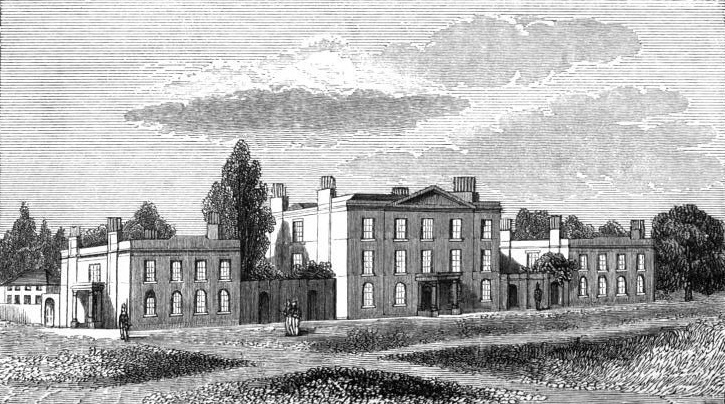
The barracks
block at Weedon, as depicted in Osborne's London & Birmingham
Railway Guide
(1840)
In 1804, Barnes built a ⅝-mile branch to service the new Depot.
The military branch canal entered the Depot under a portcullis, set
in a building known as the East Lodge, which formed part of the
surrounding wall. The canal continued into the magazine, passing
through a further smaller building and portcullis. At the far
end was yet another portcullis leading to a barge turning area
outside the perimeter wall, but barges were also able to turn in a
canal basin within the magazine enclosure.
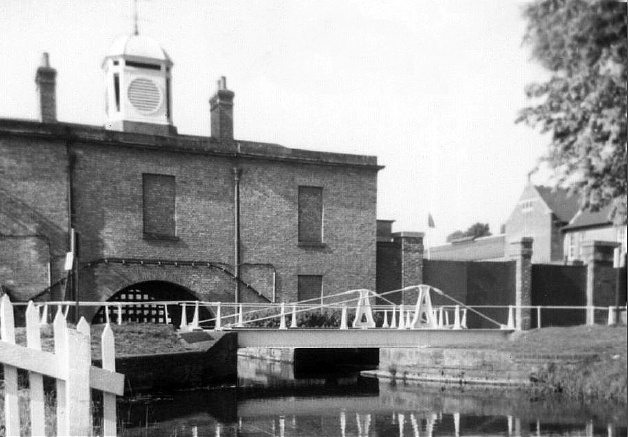
Above, the
East Lodge and portcullis; below, Barnes’s service canal.

Weedon Depot closed in 1965 and much of this interesting historic
relic has since been demolished; what remains is used by light
industry. Now isolated from the main line, Barnes’s branch
canal still runs through the middle of the site like a neglected
ornamental feature.
See also Appendix I.
――――♦――――
Gayton Junction lies a further 7½ miles to the south. Here,
the Northampton Arm heads east to the town where, at Northampton
Junction, it connects to the River Nene and onwards to East Anglia’s
waterways and The Wash.
Construction of the Northampton Arm was delayed for many years and
in that respect shares a similar history to its contemporary, the
Aylesbury Arm. Authorised in the 1793 Act and surveyed by
Barnes three years later, the Company was reluctant to build this
short link from Gayton to the River Nene due mainly to the supply of
water it would require from the main line. [6]
However, after much protest by the town’s citizens, the Company was
eventually persuaded, but to save expense Barnes was instructed to
build a double-track horse tramway using sleepers and rails released
from the now redundant Blisworth tramway and the completed Wolverton
embankment:
“GRAND JUNCTION CANAL.―We
are happy to announce the completion of nearly all the great works
which are going on upon this important and extensive line of
navigation. On Monday morning last, the stupendous embankment
between Wolverton and Cosgrove, near Stony-Stratford, was opened for
the use of the trade. By this great work nine locks by its side,
four down and five up, are avoided, and one level sheet of water is
now formed, from Stoke Bruerne to some miles south of Fenny
Stratford (this overlooks the lock at Cosgrove), as well as
on the Buckingham branch, extending to within a mile of that town.
The embankment seems to possess great stability.
The branch and iron railway, that is to connect the Grand
Junction Canal with the New River at the town of Northampton, as
also with the Leicestershire and Northampton Union Canal, are
proceeding rapidly, and their completion may be expected about the
end of next month.”
The Morning Post, 30
August 1805
. . . . but as mentioned earlier, the Leicestershire and Northampton
Union Canal was never to reach Northampton.
Opened in 1805, the Northampton tramway was operated by the firm of
Pickfords, which relocated from Blisworth wharves from where it had
operated the hill tramway. But that to Northampton proved
unpopular, and in 1810, after much protest by the town’s citizens,
the Company agreed to construct a narrow canal, although work on it
did not commence for a further three years. Built by Benjamin
Bevan to Barnes’s survey, the 4¾ miles Northampton Branch opened on
May 1st, 1815 to the usual celebrations:
“On Monday May 1, was opened the Branch Canal between the River
Nene, at Northampton, and the Grand Junction Canal. The day
being remarkably fine, a great multitude of persons assembled to
watch the first arrival of the boats, several of which were laden
with various kinds of merchandise, manufactured goods &c. &c. from
Ireland, Liverpool, Manchester, Yorkshire, Lancashire, Cheshire, &c.
&c. and upwards of twenty with coals. From the greater
facilities thus afforded to trade, particularly in the article of
coals, the inhabitants of Northampton and neighbourhood may
reasonably anticipate considerable advantage. After mooring
the boats, amidst the firing of canon, different parties spent the
remainder of the day with the utmost conviviality.”
The Leicester Journal,
12th May, 1815
The limit of navigation was later extended to West Bridge, with
wharves being built to serve mills, timber and coal yards.
Although a steady trade was established, it never attained a
sizeable volume due mainly to the narrow locks that restricted the
size of craft able to use the branch.
――――♦――――

|
Southern entrance to Blisworth Tunnel. The
concrete ring (bottom left) is one of the reinforcing
liners
inserted throughout the central third of the tunnel’s
length during major repairs carried out in 1982-84. |
The village of Blisworth lies just to the south of Gayton Junction.
The canal reached Blisworth from the north in September 1796, but it
was not until the Blisworth Tunnel was opened in 1805 that a direct
link with the south was established. In the intervening
period, Blisworth Wharf, operated by Pickfords among others, became
the busiest inland port in England.
Pickfords was already an established London-based road carrier when,
in 1778, the firm began to convey goods by barge as well as by
wagon. At this time the firm’s operations were being conducted
by 50 wagons, 400 horses and 28 barges, and by 1800 they had added 8
canal depots. In 1803 their canal services reached Birmingham,
and the firm went on to establish warehouses and wharves at London
(City Road and Paddington) and at Brentford. They advertised
two classes of services:
-
‘fly boats’
travelling day and night with two steerers and two drivers (for
the horses) at 3 to 3½ mph, covering 40-miles a day in stages,
with fresh horses at each stage;
-
by barge at 25
miles per day, with two men resting at night.
An article on canals in Rees’s
Cyclopedia of 1805 praises Pickfords fly boat services “which
travel night and day, and arrive in London with as much punctuality
from the midland and some of the most distant parts of the kingdom,
as the waggons do.”
During construction of the Blisworth tunnel, the village became a
transhipment terminal for the goods being carried road over
Blisworth Hill to the Northampton to Old Stratford turnpike.
Land was taken by Messrs. Barnes (he of the Canal), Roper & Co. and
rented to canal carriage companies, including Pickfords, on which to
erect warehouses. However, the Grand Junction Canal Company
received intelligence that their Resident Engineer was lining his
pockets to their detriment; worse still,
“. . . . that Roper and Barnes having no inconsiderable weight in
the Councils of the Directors, it is probable that the navigation
may stop at Blisworth many years, possibly for ever”. [7]
And so the Company’s Northern Committee, which included the Marquis
of Buckingham, “. . . thought it their duty, in consequence of
some complaints, to navigate the Canal from Braunston to Blisworth,
and to enquire into the state of the Company’s concerns in that part
of the line.” Their inspection found all to be above
board, and that “. . . the part Mr. Barnes has taken in this
concern has been with the purest and best motives; and that the
Company have derived a very considerable emolument from his
exertions”. [8]
But road communication across Blisworth Hill proved unsatisfactory,
and so the pioneer rail engineer Benjamin Outram was employed to
construct a double-track, horse-drawn tramway. The tramway was
in operation by mid 1800 and remained in use until the tunnel was
opened to much celebration and the customary dinner in 1805:
“THE GRAND JUNCTION
CANAL – That grand line of
communication, between the metropolis and the most distant parts of
the kingdom, which the Grand Junction Canal was to effect, was
incomplete till Monday last, owing to a range of high land between
Stoke Bruerne and Blisworth, in Northamptonshire, not being
penetrated by a tunnel or arch, as intended; but all goods coming
past that place, have been obliged to be unloaded, and placed on
waggons, and conveyed on a railway over the hill, to be embarked
again in other boats.
On Monday morning, the weather proving very fine, an amazingly large
concourse of people were assembled, some of them from considerable
distances, to view the stupendous works at Blisworth Tunnel, and to
see the grand procession in honour of the opening of this internal
communication by water, between the most distant places. One of the
Paddington packet-boats, called the Marquis of Buckingham, was the
first boat which went through the tunnel. The principal
company retired to the Bull Inn, at Stoney Stratford, and, about six
o’clock, 120 proprietors and friends of this grand undertaking, sat
down to an excellent dinner. Mr. Praed in the chair.”
Morning Chronicle, 30th
March, 1805
There being no further use for the railway, it was dismantled and
the materials reused in the construction of the Northampton tramway.

Horse
tramway (or plateway).
――――♦――――
The Blisworth tunnel ― 3,056 yards in length ― lies to the south of
the village and is approached at both its ends through substantial
cuttings. There is sufficient width within the tunnel for
narrow boats to pass, but not wide boats. The tunnel has no
tow path; the barge horses were led over Blisworth Hill while the
boat crews ‘legged’ through.
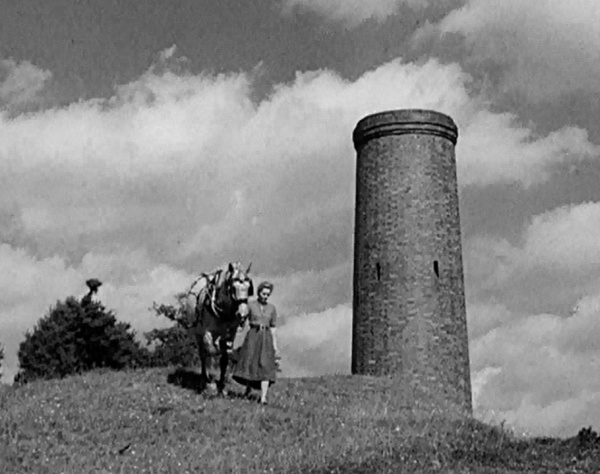 |
|
Walking the barge horse over Blisworth Hill. On
the right is a ventilation shaft ―
a former ‘pit’, built to service the tunnel while it was
being built. A number of them
were afterwards extended into the chimney-like
structures seen today. |
In the age preceding mechanical propulsion, where a tunnel did not
have a tow path one method of propelling a boat through was by the
use of human legs placed against the tunnel roof or (in the case of
the Braunston and Blisworth tunnels) the walls. This practice,
known as ‘legging’, required two people to perform. Each lay
at opposite ends of planks (‘wings’) placed across the bows of the
boat. Holding the plank with their hands, they then walked the
boat along using their feet against the tunnel walls.
Professional leggers were available, who in the early days of the
Canal sometimes terrorised the boatmen into employing them, which
led to complaints about:
“. . . the nuisance arising from the notoriously bad characters
of the persons who frequent the neighbourhood of the Tunnels upon
the plea of assisting Boats through them.”
Grand Junction Canal Company Minute Book,
10th November, 1825
Eventually, in 1827, the leggers were registered and employed by the
Company who issued them with brass armlets for identification. They
were paid a standard rate of 1s 6d for a single trip, Blisworth men
working south and Stoke Bruerne men north. In 1859, the
novelist Charles Dickens commissioned John Hollingshead to write a
number of travel articles to appear in the periodicals that Dickens
published. Among them is an account of a journey that
Hollingshead made along the Canal, which includes a description of
legging a narrow boat through Blisworth Tunnel (Appendix
II.).
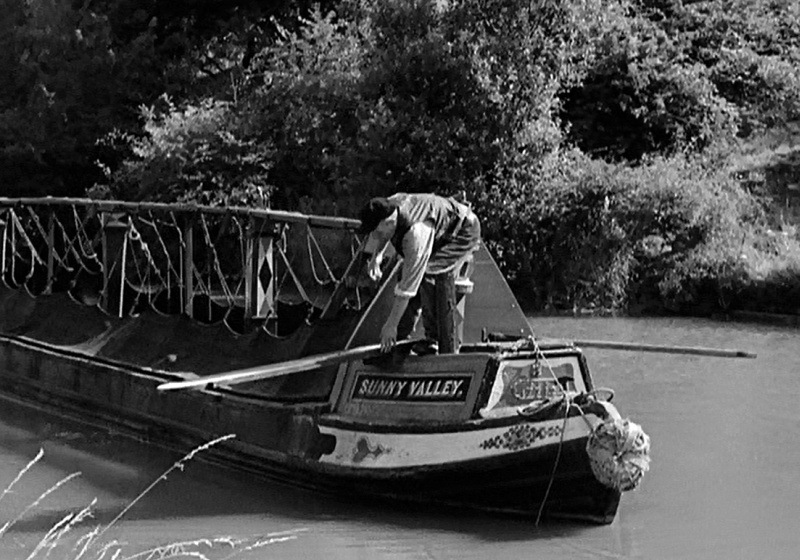
Above: fitting the wings (or legging
boards). Below: legging.
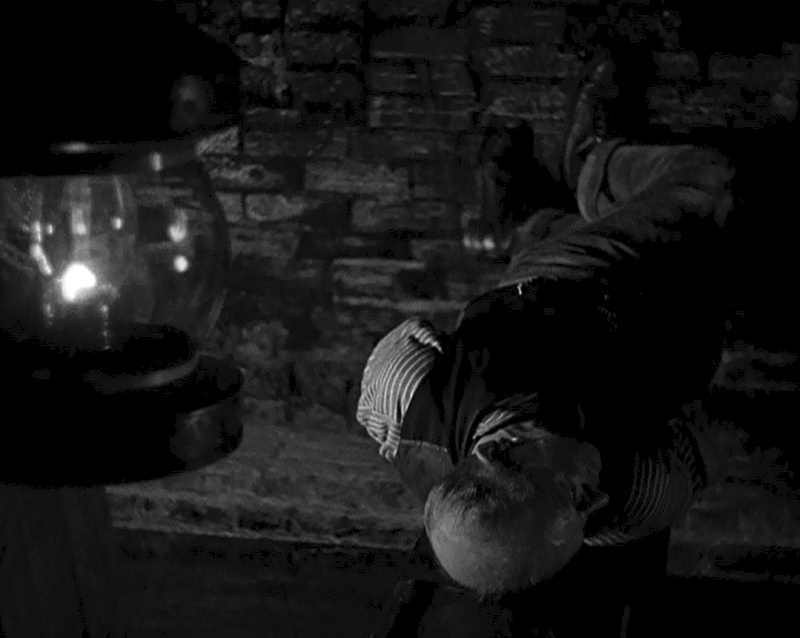
When steam tugs appeared in 1871, the professional leggers were made
redundant; this from the Company’s Minute Book:
26th April 1871: Mr Mercer reported that a tug was now at
work at the Braunston Tunnel and that the same charges were being
made as at the Blisworth Tunnel viz: Boats with cargoes of 25 tons
or upwards each, 1/6d each way. Boats with cargoes of under 25
tons, 1/3. Empty boats 1/-. And that the services of the
leggers would no longer be required . . . Resolved that a weekly
allowance of 5/- each be made to [former leggers] Mr
Benjamin, 75 years of age and 44 years at the tunnel. R
Thomas, 65 years of age and 38 years at the tunnel and John Fox 64
years and 19 years at the tunnel.
But the new steam tugs were not universally welcome:
6th June 1871: Letter from Mr Cherry reporting that some
of the boatmen refused to avail themselves of the Tugs in use at the
Blisworth and Braunston Tunnels . . . . Resolved that all boats
using Blisworth and Braunston Tunnels between the hours of 4 am and
8 pm be hauled through the same by the Company’s tug at the
following scale of charges viz: Boats with cargoes of 25 tons or
upwards, 1/6d each way. Boats with cargoes of under 25 tons,
1/3. Empty boats 1/-. Any boatman refusing to have his
boat so hauled be charged a sum not exceeding one penny per ton for
the weight on board.
The introduction of steam propulsion was not without other problems.
Ten years earlier, two fatalities had occurred:
27th September 1861: The chairman reported that on the 6th
inst an accident had occurred on board one of the Company’s steam
boats in the Blisworth Tunnel, by which two men, Webb and Edward
Broadbent had been suffocated and two men severely burnt and that
every possible attention had been given to the men injured who were
now in the Northampton Infirmary and that the sum of £45 had been
given by the Company to the widows of the deceased persons.
The need for better ventilation led to the uncovering of some of the
‘pits’ that had been sunk during the tunnel’s construction; seven of
the nineteen originally built are now used for this purpose, the
others have either been capped or filled in. A heavy build-up
of soot on the tunnel brickwork was another problem associated with
steam propulsion, which led to the introduction of a ‘brushing’
hopper. Fitted with a curved brush that matched the tunnel’s
profile, the craft was towed through the tunnel, its brush sweeping
the soot from the brickwork into the hopper.
Horse-drawn traffic continued on the Canal until well into the 20th
century, necessitating a continuing need for tugs:
“Although the old horse-drawn boats are rapidly being replaced by
motor-driven craft, the Canal Company still maintains a regular
service of tugs for the towage through the tunnel [Blisworth and
Braunston] of craft which cannot proceed under their own power.
At Blisworth the Company has a warehouse of five storeys, for the
storage of goods of all kinds.”
From a Grand Union Canal Company
publicity article (1937)
The “regular service of tugs” was withdrawn in the following
year.
The village of Stoke Bruerne lies a short distance from the southern
end of Blisworth Tunnel. When the canal reached Stoke from the
south in September 1800, this village also became a busy
transhipment terminal for canal goods conveyed over Blisworth Hill
on Outram’s horse-tramway. Today, Stoke is known for its Canal
Museum. Founded in 1963 by Charles Hadlow, an engineer, and
Jack James a boatman turned lock keeper, it was the first museum
devoted to our inland waterway heritage, although it has since been
joined by others at London (Battlebridge Basin), Gloucester and
Ellesmere Port.
――――♦――――
From Stoke the canal descends through a flight of seven locks to
reach its next level, the 5½-mile Cosgrove pound; only the lock at
Cosgrove separates it from the adjoining Fenny pound.
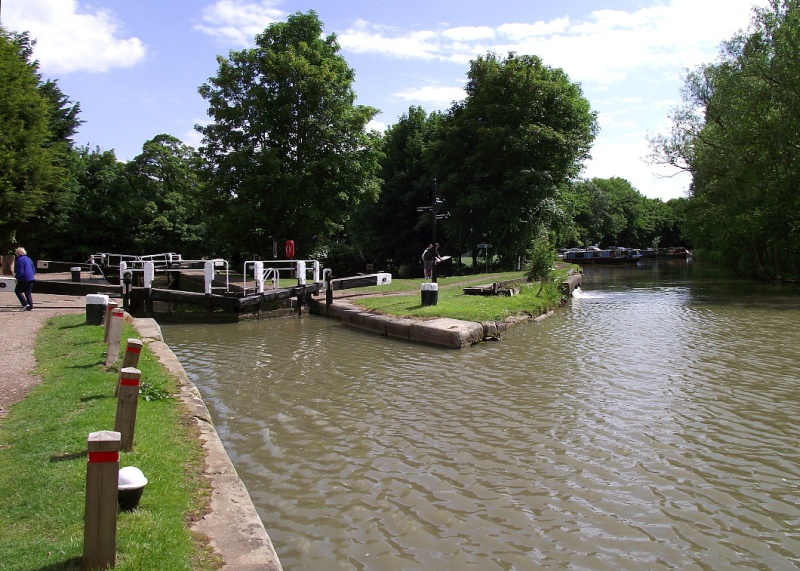
|
The main line descends through
Cosgrove Lock (No. 21) on the left. To the right
is the remnant of the branch to Stony-Stratford and
Buckingham, now used as moorings.
Rails set into the towing path signify that
Cosgrove
once
exported sand and gravel, the worked out pits (now
flooded) being visible from Cosgrove embankment. |
The main line passes through Cosgrove village, following the right
bank of the Tove to near its confluence with the Great Ouse. A
public wharf was established about half a mile north of Cosgrove,
where the road to Castlethorpe crossed the canal. This is
Castlethorpe Wharf (a.k.a Thrupp Wharf), and it hosts a public
house, the Navigation Inn. When the Inn was put up for sale in
1876, the wharf was described thus:
“The excellent WHARF-YARD, with landing for tying-up eight boats;
coal and coke yards, lime-kiln, capital warehouse (capable of
storing 150 quarters of corn), salt-house, granaries,
weighing-house, with weighing machine; stabling for eleven horses,
lock-up coach-house, large barn, with slated roof; piggeries,
excellent walled kitchen garden, and other appurtenances thereto
belonging. There is a COTTAGE, containing three rooms,
Adjoining, which is now used as a warehouse. And also all the CLOSE
of first rate Arable LAND, containing 9¾ Acres, or thereabouts,
adjoining the before mentioned Property, and fronting the road
aforesaid; together with A CLOSE of excellent Pasture LAND,
containing 11½ Acres, or thereabouts, adjacent thereto, with good
thatched hovel, and appurtenances created thereon, the whole being
now in the occupation of the said John Ayres.”
Cosgrove lock (No. 21) lies at the junction with the former Stony
Stratford and Buckingham Arm. Authorised in the Grand Junction
Canal Act of 1793 and originally planned as a short branch to Old
Stratford and the busy highway of Watling Street (the A5), the Arm
was soon extended a further 9¼-miles to Buckingham, [9]
principally at the instigation of the Marquis of Buckingham who
loaned the Company the construction cost:
“The branch of the Canal from Buckingham to the Grand Junction
Canal was opened this day with great rejoicings. A barge with
the Marquis of Buckingham, Mr. Praed, and Mr. Selby (Gentlemen of
the Committee) and Mr. Box, the Treasurer, accompanied by a large
party of Ladies and Gentlemen, and a band of music, led the way to
the procession of 12 barges, laden with coal, slate, and a variety
of merchandise. Upon their entrance to the basin at Buckingham
they were saluted by the firing of several cannon. A numerous
party were handsomely entertained by the Marquis of Bath at the
‘Cobham Arms Inn’ on this occasion, and a liberal supply of beer was
given to the populace. This branch of the Canal, 9¼ miles in
length, has been completed in about eight months, and will secure to
an extensive distance of country most substantial benefit.”
The Gentleman’s Magazine,
1st May 1801
As elsewhere, water-borne transport was to have a considerable
impact on the town and its locality. Coal, stone, bricks,
manufactured goods, imported produce from London Docks were all more
readily available at much lower cost than ever before; and local
produce could be moved faster and more easily, whether it was
foodstuffs to the local market, or loads of hay and straw destined
to nourish and sustain the motive power of the Metropolis.
Within a few years, trade on the branch had reached 20,000 tons per
annum and was to remain at this level for almost fifty years.
The first section of the Arm to Stratford was, in common with the
main line, built as a wide canal, but the extension to Buckingham
was built narrow. Its route led over easy ground, only two
locks being required, so construction progressed quickly. In
its early days the Arm was successful, but from the 1850s railway
competition led to its decline, which was further aggravated by
leakage and by Buckingham Corporation using it as a dump for the
town’s sewage, which caused silting. By 1904, Bradshaw’s
Guide was describing its upper section as being “barely
navigable” and by the 1930s the Arm was derelict. All that
now remains is a section of about 100 yards, which extends westwards
above Cosgrove lock and is used for moorings. The remainder of
the canal has been filled in, although there is an ambitious
restoration scheme, the Patron of which is the present Speaker of
the House of Commons.

|
A relic of the Canal’s horse
drawn days, the Cosgrove horse tunnel
enabled barge horses to
be led under the Canal to the stables. |
――――♦――――
Immediately to the south of Cosgrove lock, the Canal crosses the
valley of the Great Ouse on a substantial mile-long embankment:
“All the works of that extensive and complicated undertaking, the
Grand Junction Canal, are now completed. The stupendous
embankment that had been raised between the villages of Wolverton
and Cosgrove, near the market town of Stony Stratford, has been
lately opened for the use of trade and internal navigation. . . .
The arches erected under this embankment, to create a passage for
the river Ouse, which arches were believed and reported to be in a
sinking state soon after the central arches were struck, are at
present considered as sufficiently firm, and the embankment is
thought to possess all imaginable strength and durability.”
The Universal Magazine of Knowledge and Pleasure,
July-Dec, 1805
Reference to the “arches were believed and reported to be in a
sinking state” refers to the three arches of a brick-built
aqueduct, designed by Jessop, which carried the embankment over the
Great Ouse. When the timber shoring was removed the aqueduct
began to show signs of failure . . . .
“After its erection Mr. Bevan, the engineer, of Leighton Buzzard,
being called upon, gave it as his opinion, it would not stand twelve
months; his prediction was verified, for in less than six months
after its construction, the materials were so indifferent, that a
continued leak of the aqueduct was observable.”
A Tour of the Grand Junction
Canal in 1819, John Hassell (1819)
The embankment had experienced slippage in 1806, shortly after its
opening. This was repaired, to be followed in February 1808 by
failure of the aqueduct:
“On Friday morning last the inhabitants of this town were thrown
into the utmost consternation, by information which arrived from
Wolverton, that the large embankment for carrying the new line of
the Grand Junction Canal across our valley, about a mile below this
town, had fallen in; and that the river Ouse was so dammed up
thereby, that this town must shortly be intirely inundated to a
great depth. I hastened to the spot, where my fears were very
much allayed, by finding that one of these arches, which had been
propped up underneath with timber, soon after the centres were
removed, was still standing; and that this one arch, owing to there
being no flood in the river, was able to carry off the water of the
river as fast as it came down. On examining the other two
arches, I found that about 22 yards in length of the middle part of
each had fallen in, and blocked up the arches, laying the canal
above in complete ruins, emptying it as far as the nearest stop-gate
on each side, and exposing the remains of 500 quarters of coke and
cinders which the contractors had lain in the arches. The ends
of each of the broken arches were found standing in a crippled
state. Most fortunately for the Public, as well as the
Company, the old line of the canal and locks across the valley are
still remaining, and in sufficient repair, immediately to convey the
barges, and prevent interruption to trade: but the loss of £400 per
month, which I am told has of late been the amount of extra tonnage
received by the Company for goods passing over this embankment, will
be lost to them during the period of re-building the arches and
repairing the canal over them.”
Jackson’s Oxford Journal,
27th February, 1808
A subsequent investigation attributed the aqueduct’s failure, not to
deficiency in Jessop’s design, but to poor workmanship on the part
of the contractor. The legal dispute with the contractor that
followed was settled in the Company’s favour, with damages being
awarded for loss of trade and the cost of the replacement.
Today, the Great Ouse is bridged by Benjamin Bevan’s iron trunk
aqueduct of 1811:
“The new aqueduct bridge of the Grand Junction Canal, over the
Ouse River, below the town of Stoney Stratford at Wolverton, which
has been for some time in preparation, of cast iron, in lieu of that
of brick, which fell down in 1808, was on 22nd January, at one
o’clock, opened for the passage of boats, the Empress,
belonging to Mr. Pickford, and his Queen Charlotte, being the
first of 30 which passed this first metal aqueduct that has been
constructed anywhere in the South of England. ― The whole length of
the iron-work is 101 feet; it is wide enough for two boats to pass
each other, and has a towing path of iron attached to it; it is firm
and tight in every part. Mr. Benjamin Bevan, the Engineer who
designed it, and about twenty persons only besides the boatmen were
present, no announcement having been made of its completion.
The opening of this Aqueduct and the passage of trade over the
embankment, will, it is expected, add full £500 per month to the
revenues of the Company.”
The Tradesman Vol. VI.,
Jan - June, 1811
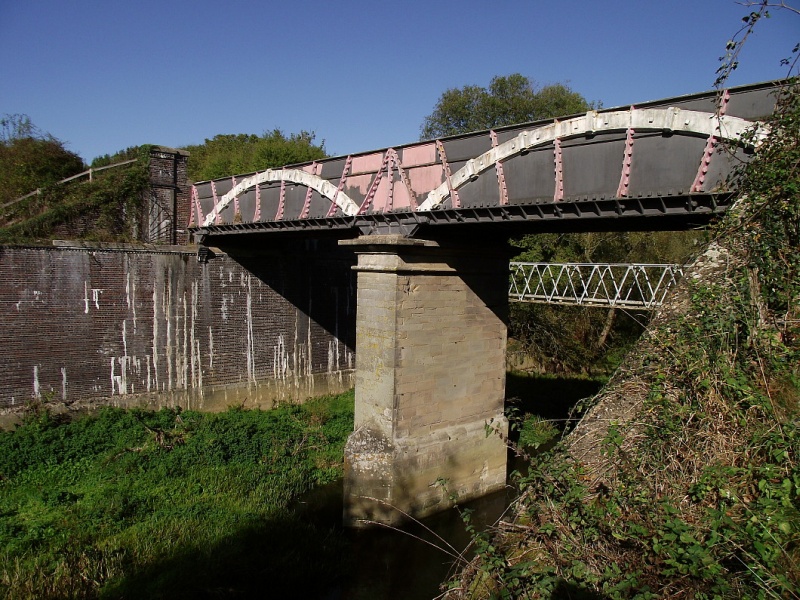

Benjamin Bevan’s
cast iron trunk aqueduct of 1811.
――――♦――――
The Canal now enters Wolverton, the first town of any size on its
southward journey. Wolverton was once home to the London and
Birmingham Railway Company’s locomotive works before this was
transferred to Crewe, after which Wolverton Works concentrated on
the manufacture and repair of rolling stock. At Wolverton, the
Canal passes under the former London and Birmingham Railway ―
which Robert Stephenson conveyed across the Ouse Valley on a fine
brick-built viaduct (1838) ― before crossing Grafton Street on the
New Bradwell aqueduct (1991). It then commences a circuitous
journey around the eastern outskirts of Milton Keynes, during which
it becomes a travelling companion to the River Ouzel [10]
until their paths eventually diverge at Grove Lock, to the south of
Linslade.

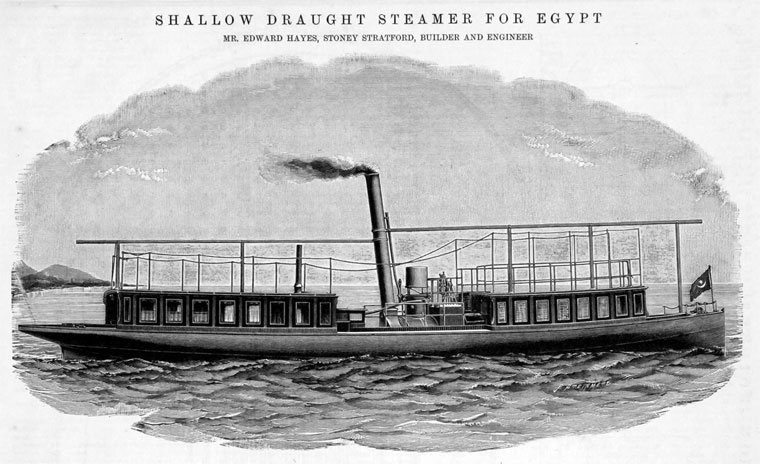
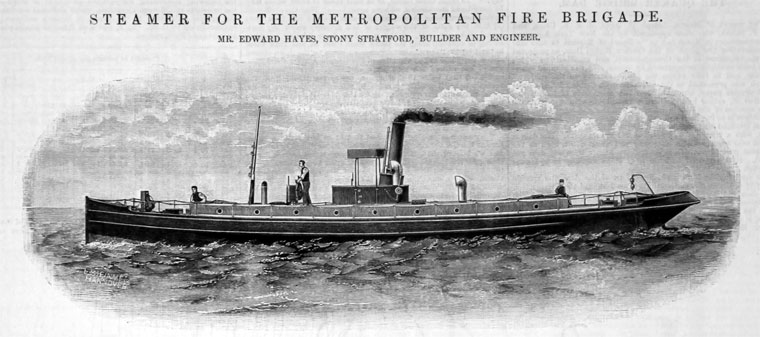
Stony Stratford lies to the south-west of the canal at Wolverton.
Here, at ‘Watling Works’, the engineering firm of Edward Hayes was
once located. Although originally in the agricultural
engineering business, the firm was to make its mark in
boat-building, not canal boats, but steam boats of various
descriptions for coastal and harbour work ― and this despite being
some distance from the Canal and many miles from the sea:
“In 1845 the late Mr. Edward Hayes started the works for general
engineering, but gradually the business has become confined to the
building of steam yachts, tugs and launches. These are
exported to all parts of the world for steamers and machinery of
various descriptions have been built for the British Admiralty,
Crown Agents for the Colonies, the Board of Works, Trinity House
Pilots, the Shah of Persia, the Sultan of Morocco, besides various
foreign governments and well-known shipping lines. During the
late South African War a little steamer destined to work in
connexion with the landing of troops and stores actually steamed
from the place she was launched, the Old Stratford Wharf, which is a
branch of the Watling Works, along the Grand Junction Canal to the
Thames and thence to Delagoa Bay, South Africa.
In Stony Stratford it is not an unusual sight to see one of these
steamers being drawn on large eight-wheel trolleys by a powerful
traction engine from the Watling Works, where they are built, to the
wharf half a mile away, and often followed by its engine and boiler
on separate trolleys . . . . The steamers originally built for the
riverside work of the Metropolitan Fire Brigade came from the
Watling Works, and the present Mr. Edward Hayes has taken out
numerous patents for improving steamers, one of the most recent
being for cheapening and facilitating the exportation of small
steamers abroad, making it possible to erect steamers at the site of
their work and where only unskilled native labour can be obtained.”
The Victoria History of Buckinghamshire
(1908)
The steamer that sailed to South Africa was the 65ft Curlew.
Built in 1902 and launched into the Canal, she then set off for
London, grounding on a shoal at Leighton Buzzard en route
from which she was hauled by a team of horses. Having reached
the Port of London under her own steam and successfully completed
her trials, she then sailed on to her overseas customer. The
larger of Hayes’s vessels built for export were prefabricated.
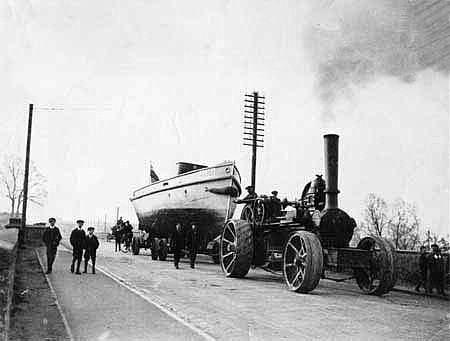
The firm ceased boat-building in 1923 due to the glut of small
war-surplus vessels on the market, but at least one of their craft
survives. Following her retirement from the Thames Water
Conservancy Board, the river tug Wey (originally named Pat)
was repatriated and is now on display at Milton Key Museum.
――――♦――――
|
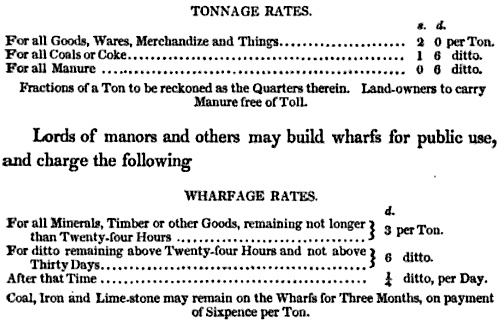 |
|
Newport Pagnell Canal: charges authorised under its Act |
At Great Linford the canal approaches the
M1 (north of junction 14) and the site of the junction with the
former short ― and short-lived ― Newport Pagnell Canal (1¼-miles).
As with the Aylesbury and Northampton arms, the Grand Junction Canal
Company were unenthusiastic about building this branch, the view
being that as Newport lay close to the main line there was nothing
to justify a branch. But the citizens of the town disagreed.
In 1813, after some years of fruitless argument, they decided to
promote the branch themselves while harbouring the grander ambition
of extending it eventually to Olney, Bedford and beyond.
Benjamin Bevan surveyed the line, an Act was obtained in 1814, work
commenced in 1815, and the canal, built as a broad canal, opened
early in 1817.
During its comparatively short life the Newport Pagnell Canal
remained in the ownership of its promoters, and while their grander
ambitions were unfulfilled, the Canal did pay a modest dividend
throughout most of its life. In 1864 the Canal was bought by
the Newport Pagnell Railway Company who used part of it for their
track bed. [11]

Proposed canal linking
the Great Ouse at Bedford with the Grand Union Canal at Milton
Keynes.
Bedford and
Milton Keynes Waterway Trust.
――――♦――――
Fenny pound extends for 11½-miles from Cosgrove lock southwards to
Fenny Stratford. Located just to the east of Watling Street
(the A5), Fenny Stratford lock provides the unusually small rise of
12 inches, for it was never intended to form a permanent feature of
the canal. Its purpose was, as a temporary measure, to control
leakage through the uppermost part of the canal banks in Fenny pound
by reducing the water level. The problem was addressed in
1802, but although the Company considered removing the lock on more
than one occasion, they were deterred by the cost and disruption to
canal traffic, and the ‘temporary’ lock lives on.
The Canal was opened to Fenny Stratford in 1800, the event
attracting public celebration and ending with the customary dinner
for the Company hierarchy:
“The Grand Junction Canal was on Wednesday opened for barges from
the Thames at Brentford, to Fenny Stratford, and early in the
morning a number of boats started from Tring, at which place the
canal has been completed these two years past; about one o’clock
they passed through Leighton; and a short distance before they
reached Fenny Stratford the Marquis of Buckingham, accompanied by a
number of friends and principal proprietors, attended by the band
and a party of the Buckinghamshire Militia, met them. They
then went in grand procession to Fenny Stratford, where they were
received with firing of cannon belonging to the town, and other
demonstrations of joy. The Marquis and the proprietors retired
to the Bell Inn to dinner.”
Jacksons Oxford Journal,
31st May, 1800
By the 1930s, regular local trade on the Canal appears to have
mostly died out on the section of the Canal north of Berkhamsted,
with Grand Union Canal Company publicity material of the period
identifying very few of the wharves with tenants. Of those
that are listed, most are located along the section from Fenny
Stratford to the Leighton area:
|
 |
|
Grand Union
Canal Company route map, c.1938. |
“At this point thousands of tons of Leighton sand are loaded from
the adjoining pits . . . and taken by canal boat both to Paddington
and Brentford for distribution to all parts of London. Mr L.
B. Faulkner, one of the long distance canal carriers, has his depot
and boat repairing yard at Leighton Buzzard. . . . At Fenny
Stratford, quantities of farina [12]
and sugar are landed from steamers in the River Thames.”
Grand Union Canal Company
publicity material,
c. 1938
The farina and sugar referred to was probably destined
for Valentin, Ord and Nagle, a tenant listed at Fenny
Stratford wharf who manufactured brewing sugars from
grain brought in by narrow boat.
Before the Canal reached Leighton, the deposits of sand
in the locality had been used by building firms and in
tile-making, but the Canal’s arrival opened up a much
wider market. Local hauliers transported the sand
from quarries for loading into barges at canal-side
wharves, from where it was shipped to London and to the
Midlands. But the constant passage of carts
through the town caused such damage to the roads that
the Council demanded that the sand firms set up an
alternative form of transport. This led, in 1919,
to the building of the 2ft gauge Leighton Buzzard Light
Railway. Constructed from war surplus materials
and equipment, the railway became the main means of
moving sand from the quarries in the north of the town
to its southern outskirts where the grading and washing
sheds were situated and from where there was good access
to the Canal and the mainline railway. But
transport by canal and rail declined in the years
following the Second World War, for road haulage could
deliver faster and more directly. From the 1950s
onward, Leighton Buzzard became home to many road
haulage firms specialising in the transport of building
aggregates, while the light railway has become a popular
attraction for tourists and those with an interest in
the industrial narrow gauge.
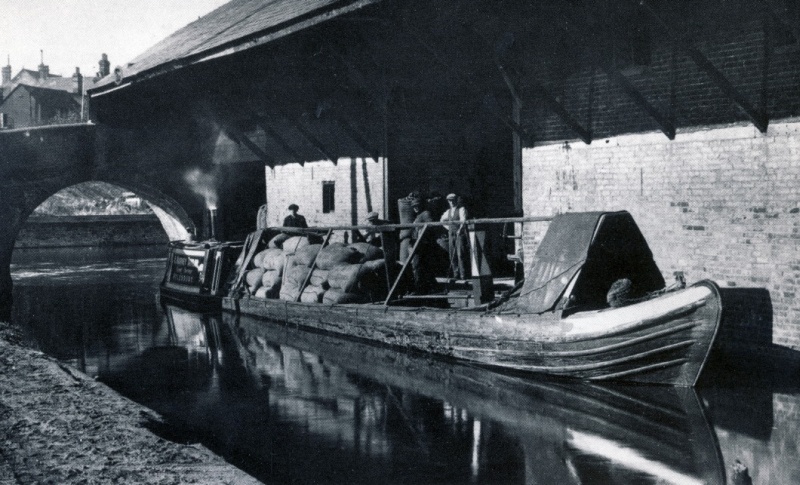
Brantom’s Dock (with
towing path bridge) in operation ― and following its transformation
into an office block.
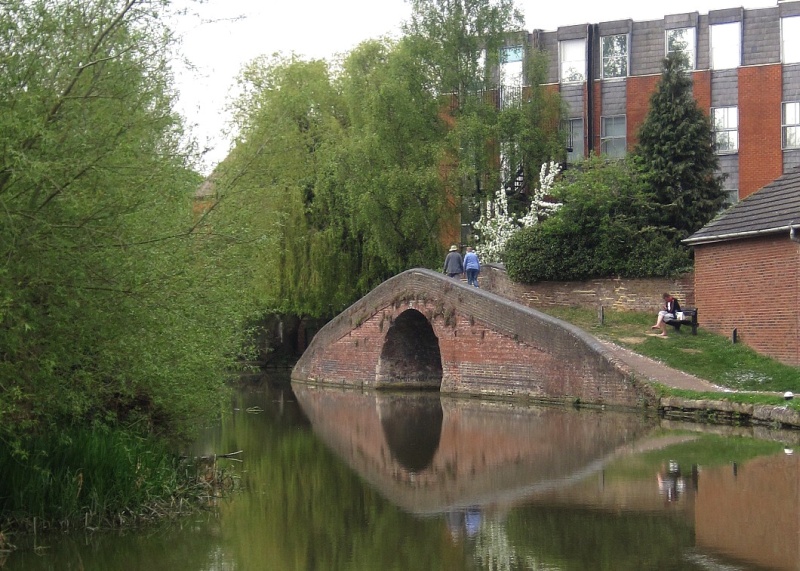
Linslade hosted a number of wharves. Sandhole Bridge had
wharves that served the sand quarries of Heath & Reach.
Whichello’s Wharf, named after Stephen Henry Whichello and Son, coal
merchants, was situated to the north of the busy Leighton Road
bridge and on the west bank of the canal. To the south of the
bridge, on the opposite bank, was the dock of Grant and Lawson,
later known as Brantom’s Dock. Both served as coal
yards, timber yards, agricultural machinery suppliers, brick and
tile manufacturers, etc., and they undoubtedly attracted
industry and commerce to this new part of the town. [13]
Both wharves had rectangular basins perpendicular to the canal for
loading and discharging, with various warehouses, offices and other
buildings set around. In 1974 the basin serving Brantom’s
Wharf ― by then choked with weeds and mud ― was filled in to make a
car park, but its attractive towing path bridge was preserved
through the efforts of the Leighton Buzzard Preservation Society.
Traces of another of the canal-side wharfs, Garside’s Wharf,
also exists complete with its semi-inset 2ft-guage railway track.
This line was not part of the Leighton Buzzard Light Railway, but
served Grovebury Quarry and connected with other tracks serving
quarries and works in the area to the south of the Linslade to
Dunstable railway branch, and east of the Canal. It appears to
have been horse-operated at first but later used locomotives.
The last boatload of sand was shipped from the wharf in 1965.
――――♦――――

The three
locks at Soulbury. One of the ‘northern engines’ pumping
stations is on the right.
At Fenny Stratford the Canal begins its gradual ascent to Tring
summit, and over the next 16½ miles ― much of it in company with the
River Ouzel ― it negotiates a further 14 locks [14]
rising by 105ft. Within this section there is an attractive
flight of three locks at Soulbury together with an old steam pumping
house, one of what became known as “The Northern Engines”.
Ensuring an adequate depth of water was always at the forefront of
the canal builder’s mind, particularly at summits where recourse to
steam pumping from reservoirs was often necessary. Even then,
prolonged drought could bring traffic to a near standstill, and
there are records of the cost of pumping coupled with the decline of
traffic due to low water making a substantial dent in the Company’s
profits (referred to in
Chapter XIV). In 1838, to help alleviate this problem,
the Company awarded a contract to Grissell and Peto to build nine
engine houses and culverts between Fenny Stratford and Marsworth,
the aim being to pump lockage water back up the canal from the
valley of the Ouzel to the Tring reservoirs. By 1841 the
engines were in operation and capable of pumping water around
seventeen locks. The Soulbury pumping station ― to the right
in the picture above ― is one example, that at Seabrook [15]
another and particularly attractive in having been fortunate to
retain its yellow brick chimney.
|
 |
|
Seabrook pumping station |
――――♦――――
At Marsworth Junction, the Aylesbury Arm branches off to the west.
Construction of this narrow canal was authorised by the 1794 Act
(together with its contemporary, the Northampton Arm), but the
Company was reluctant to build it due in part to their concern about
the quantity of water that it would draw from the main line.
Henry Provis was appointed
Engineer, construction commenced in 1813 and the branch was opened
in either 1814 or 1815 ― oddly, there seems to be no reliable record
of exactly when. In its 6¼-mile journey, the Arm follows a
fairly straight path across the Vale of Aylesbury, descending 95ft
through 16 locks (the first two at Marsworth being a ‘staircase’ [16])
to its terminus to the south of Aylesbury town centre.
Initially the Arm was very busy, being used to transport grain,
timber, coal and building materials, but competition from the
Cheddington to Aylesbury railway, which opened in 1839, followed
later in the century by the arrival at Aylesbury of the Metropolitan
Railway, led to its decline. By the Second World War trade had
become spasmodic and the last regular delivery of coal to Aylesbury
by canal was in 1964. In the 1960s British Waterways
considered the Arm for closure, but its fortunes revived with the
growth of leisure cruising. Aylesbury Basin now hosts a marina
and is currently at the heart of a major town-centre redevelopment
programme. The Arm is also very popular with fishermen.
A more detailed account of the
AYLESBURY
ARM.
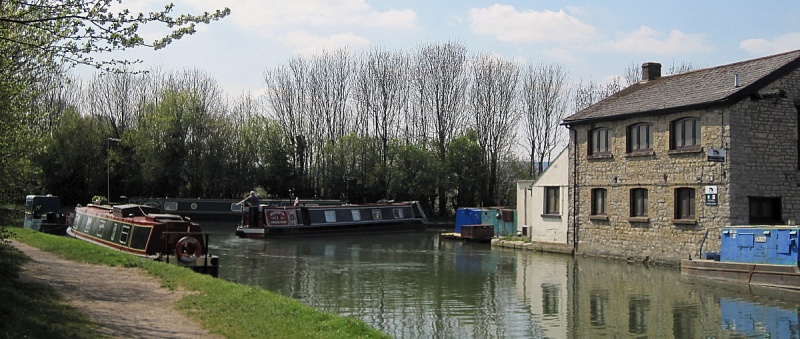
Turning into the Aylesbury Arm
at Marsworth Junction (looking south). Marsworth Wharf is on
the right.
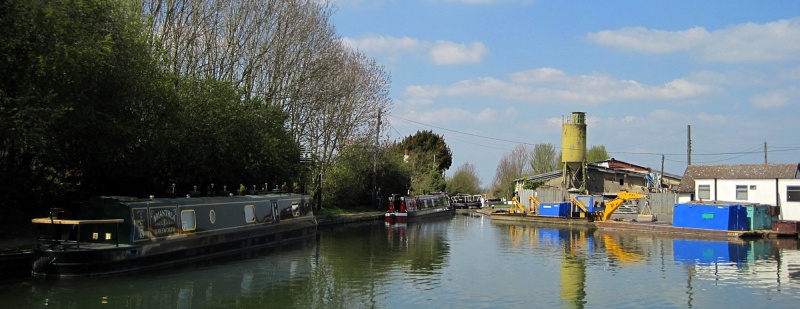
|
Marsworth Junction and the
entrance to the Aylesbury Arm.
The silo on the right
marks the site of the former British Waterways plant for
manufacturing concrete piles used for bank protection.
The wharf site has now been cleared and
is awaiting redevelopment. |
――――♦――――
APPENDIX I.
WEEDON ORDNANCE DEPOT
from
The History of Northampton and its Vicinity,
(Pub. James Birdsall, 1831)
WEEDON or Weedon Beck,
formerly called Church Weedon, but now generally Weedon Royal, from
the barracks and depot erected there; it is bounded by Nether
Heyford on the east, Dodford on the north, Everdon on the west, and
Stow with Farthingstone on the south.
The works of this depot commenced about the year 1805, and consist
of barracks originally intended for two troops of horse artillery
but now capable of containing 500 infantry; they are strong
buildings of brick erected in the form of a square; near them is a
handsome hospital. Upon an eminence contiguous to the barracks is a
most elegants edifice, consisting of a centre with corresponding
wings, built of white brick intended as a residence for the officers
of the ordnance department; which is said to have cost £18,000 in
erecting.
There are eight store-houses, four being built on each side of the
arm ot the Grand Junction Canal, which runs by this place, and a
proportionate number of work shops for the artificers. The upper
rooms of these store-houses are capable of containing 240,000 stand
of small arms, which are placed under the charge of a store keeper.
The lower rooms are appropriated for field artillery, and may be
generally computed as containing about twenty four brigades, of six
guns each, with all necessary stores, ready for service at the
shortest notice; these are under the superintendency of a field
train commissary. At an extremity of the canal branch, in an
enclosed square, completely detached from the other buildings, are
four powder magazines, one of which contains nearly 70,000 rounds of
ammunition for the field pieces; the remaining three are adapted for
powder and small arms ammunition, containing, when filled, about
5,000 barrels each. Alternately is a magazine and traverse, of equal
altitude filled with earth for the purpose of preventing extended
damage in case of explosion.
Weedon has been considerably enlarged and improved within these few
years, and now contains several neat dwelling houses some of them
being residences for officers &c attached to the depot. The quantity
of ground purchased by government for this establishment is about
170 acres.
OSBORNE'S GUIDE TO THE
LONDON & BIRMINGHAM RAILWAY
(1840)
The Royal Military Depot stands on a slight eminence, and consists
of a centre and two detached wings, with lawn in front; these form
the residence of the governor and officers, while for the common men
there are barracks on the top of the hill, capable of containing
500. At the bottom of the lawn there are eight store houses
and four magazines, adequate to contain 240,000 stand of small arms,
with a proportionate quantity of artillery and ammunition; there are
also a number of workshops for the military mechanics and a hospital
capable of accommodating 40 patients. In consequence of the
establishment of the railways, this one military force is rendered
so efficient and such power is afforded of presenting itself when
ordered by the civil authorities, in any portion of England, in the
course of a few hours, that the inutility of a number of these
expensive establishments will doubtless soon begin to attract public
attention. A troop of a few hundred men can be forwarded by
railway from this central depot to any important part of the kingdom
where their services might be required with a magical celerity and
precision that would be quite adequate to prevent mischief. A
small force permanently stationed here for such emergencies would
certainly be much more efficient than our present very numerous but
straggling military establishments, to concentrate the forces from
which, without marching to the scene of action, would often take a
much longer time than is needed in having a troop from Weedon to any
of the important districts.
――――♦――――
APPENDIX II.
ODD JOURNEYS IN AND OUT OF LONDON
by
JOHN HOLLINGSHEAD
(1860)
A journey through Blisworth Tunnel
The boatmen were preparing for the passage of the Blisworth tunnel
(nearly two miles in length), an underground journey of an hour’s
duration. The horses were unhooked, and while standing in a
group upon the towing-path, one of the child drivers, a girl about
six years of age, got in between them with a whip, driving them,
like a young Amazon, right and left; utterly disregarding the
frantic yells of a dozen boatmen, and nearly half a dozen
family-boatmen’s wives. At the mouth of the tunnel were
a number of leggers, waiting to be employed; their charge being one
shilling to leg the boat through. We engaged one of these
labourers for our boat to divide the duty with one of our boatmen;
while the youth went overland with the horse. A lantern was
put at the head of the boat; the narrow boards, like tailors’
sleeve-boards, were hooked on like projecting oars near the head;
the two legging men took their places upon these slender platforms,
lying upon their backs; and, with their feet placed horizontally
against the wall, they proceeded to shove us with measured tread
through the long, dark tunnel.
The place felt delightfully cool, going in out of the full glare of
a fierce noon-day sun; and this effect was increased by the dripping
of water from the roof; and the noise caused by springs which broke
in at various parts of the tunnel. The cooking on board the
boats went on as usual, and our space being confined, and our air
limited, we were regaled with several flavours springing from meat,
amongst which the smell of hashed mutton certainly predominated.
To beguile the tedium of the slow, dark journey— to amuse the
leggers, whose work is fearfully hard, and acts upon the breath
after the first quarter of a mile, and above all to avail themselves
of the atmospheric effects of the tunnel, the boatmen at the tillers
nearly all sing, and our vocalist was the captain’s
straw-haired son.
If any observer will take the trouble to examine the character of
the songs that obtain the greatest popularity amongst men and women
engaged in heavy and laborious employments, he will find that the
ruling favourite is the plaintive ballad. Comic songs are
hardly known. The main secret of the wide popularity of the
ballad lies in the fact, that it generally contains a story, and is
written in a measure that fits easily into a slow, drawling,
breathtaking tune which all the lower orders know; and which, as far
as I can find, has never been written or printed upon paper; but has
been handed down from father or mother to son and daughter, from
generation to generation, from the remotest times. The plots
of these ballad stories are generally based upon the passion of
love; love of the most hopeless and melancholy kind; and the suicide
of the heroine, by drowning in a river, is a poetical occurrence as
common as jealousy.
There may have been a dozen of these ballads chanted in the
Blisworth tunnel at the same time; the wail of our straw-haired
singer rising above the rest. They came upon our ears, mixed
with the splashing of water, in drowsy cadences, and at long
intervals, like the moaning of a maniac chained to a wall. The
effect upon the mind was, in this dark passage, to create a
wholesome belief in the existence of large masses of misery, and the
utter nothingness of the things of the upper world.
We were apprised of the approach of another barge, by the strange
figure of a boatman, who stood at the head with a light. It
was necessary to leave off legging, for the boats to pass each
other, and the leggers waited until the last moment when a
concussion seemed inevitable, and then sprang instantaneously, with
singular dexterity, on to the sides of their boats, pulling their
narrow platforms up immediately after them. The action of the
light in front of our boat produced a very fantastic shadow of our
recumbent boatman-legger upon the side wall of the tunnel. As
his two legs stuck out horizontally from the edge of the
legging-board, treading, one over the other, against the wall, they
threw a shadow of two arms, which seemed to be held by a thin old
man — another shadow of the same substance — bent nearly double at
the stomach, who worked them over and over, as if turning two great
mangle-handles with both hands at the same time. |